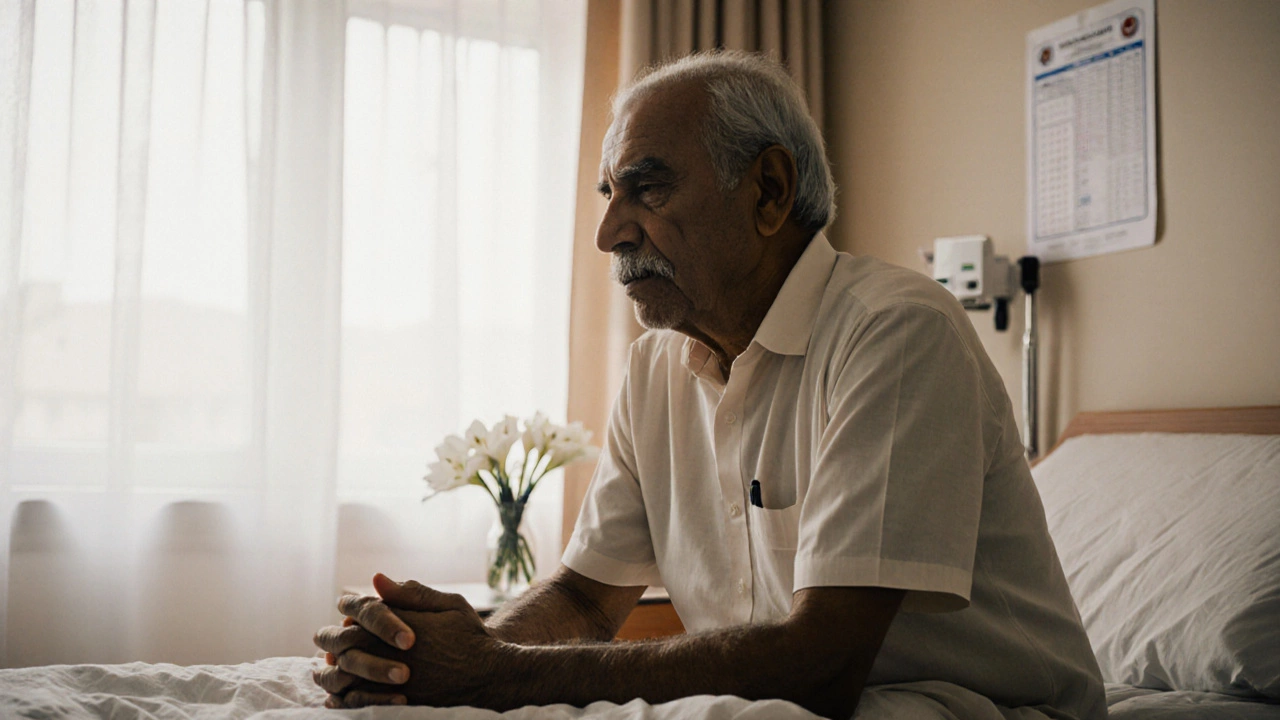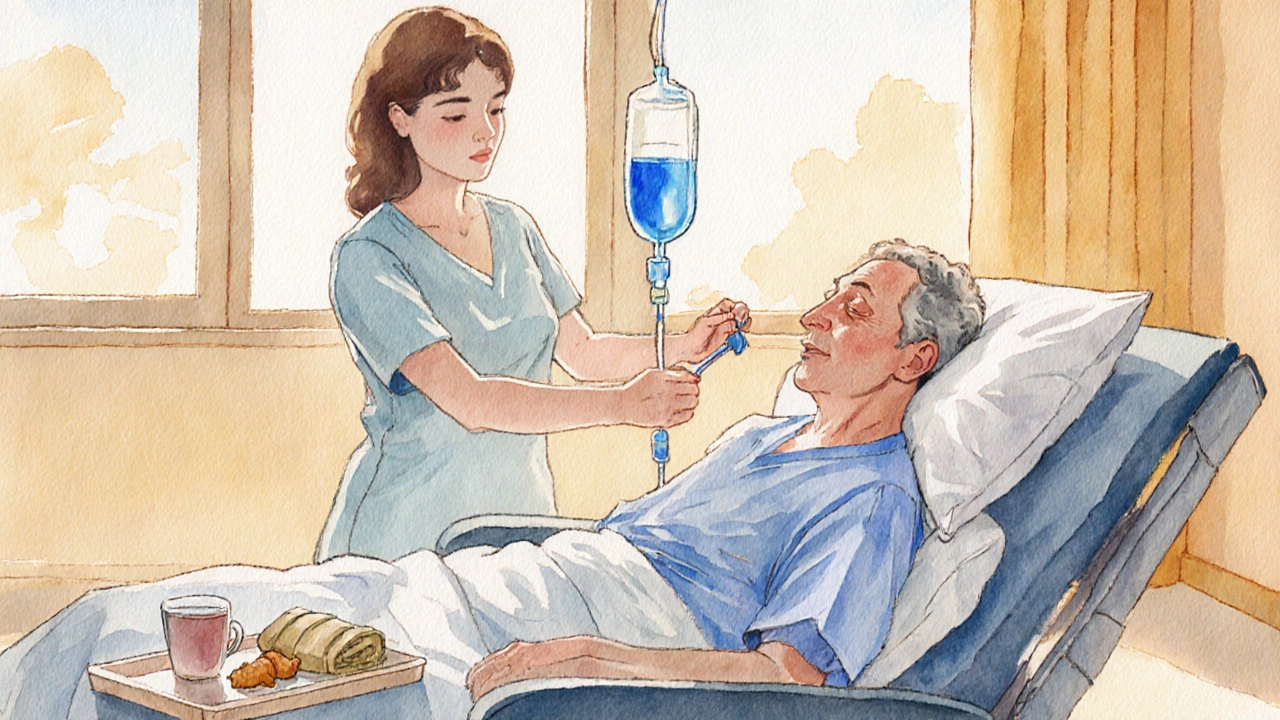
Stage 4 Cancer Treatment Decision Tool
Evaluate Your Treatment Options
This tool helps you understand the potential benefits and trade-offs of chemotherapy for stage 4 cancer based on your individual situation.
When faced with a stage4 cancer diagnosis, the question that often looms largest is whether chemotherapy-commonly called Chemotherapy is a systemic treatment that uses powerful drugs to kill or halt the growth of cancer cells-is truly worth pursuing.
Key Takeaways
- Chemotherapy can shrink tumors and sometimes extend life, but benefits vary widely by cancer type and individual health.
- Side effects range from mild fatigue to severe organ toxicity; quality‑of‑life impact is a crucial factor.
- Palliative care focuses on comfort and may be a better match when chemo offers minimal survival gain.
- Discussing goals with an Oncologist helps align treatment with personal priorities.
- Clinical trials can provide access to newer drugs that might outperform standard chemo.
Understanding Stage4 Cancer
Stage4 cancer is defined as cancer that has spread (metastasized) beyond its original organ to distant parts of the body. Because the disease is system‑wide, no single local therapy (like surgery or radiation) can eradicate it. This reality shapes every treatment decision, including the use of chemo.
How Chemotherapy Works in Advanced Cancer
Chemo drugs circulate through the bloodstream, seeking out rapidly dividing cells. In stage4 settings, the goal shifts from cure to control: slowing tumor growth, reducing painful lesions, and buying time.
Typical regimens for advanced disease are given in cycles-often three weeks on, one week off-allowing the body to recover between doses. The exact cocktail depends on cancer type (e.g., breast, lung, colorectal) and prior treatments.
Potential Benefits: What the Numbers Say
Data from large oncology databases (e.g., SEER, NCCN) show that chemo can add months to survival for several stage4 cancers. For instance:
- Metastatic non‑small cell lung cancer: median overall survival increases from 8 to 12 months with first‑line chemo‑immunotherapy.
- Stage4 colorectal cancer: adding oxaliplatin‑based chemo can extend median survival from 12 to 20 months.
- Triple‑negative breast cancer: combination chemo can push median survival beyond 18 months compared with hormone therapy alone.
However, these figures are averages. Individual response may be far better or worse. chemo for stage 4 cancer therefore demands a realistic look at personal prognosis.

Side Effects and Quality‑of‑Life Impact
Side effects of chemotherapy stem from damage to healthy rapidly dividing cells. Common issues include:
- Fatigue and weakness
- Nausea, vomiting, loss of appetite
- Hair loss
- Low blood counts leading to infection risk
- Peripheral neuropathy (tingling or numbness)
- Kidney or heart toxicity with certain agents
These effects can severely impair daily activities, especially for older patients or those with pre‑existing conditions. Quality‑of‑life (QoL) studies consistently rank chemo’s burden high, unless tumor shrinkage translates into symptom relief (e.g., reduced bone pain).
When Palliative Care Might Be a Better Choice
Palliative care is a multidisciplinary approach that focuses on symptom management, emotional support, and maintaining dignity. It does not aim to cure but to make the remaining time as comfortable as possible.
Scenarios where palliative care may trump chemo include:
- The expected survival gain from chemo is <5 months, and side effects would dominate daily life.
- The cancer type is known to respond poorly to standard chemo (e.g., pancreatic adenocarcinoma).
- The patient has significant comorbidities that raise the risk of severe toxicity.
- Personal priorities emphasize time at home with family over aggressive treatment.
Many leading cancer centers now integrate palliative services early, allowing patients to receive both symptom control and, if chosen, chemo.
Clinical Trials: Access to Cutting‑Edge Therapies
For stage4 patients, a clinical trial can provide newer agents-targeted therapies, immunotherapies, or novel drug‑combinations-often with better response rates than traditional chemo.
Eligibility criteria vary, but key steps to explore trials include:
- Ask your oncologist about ongoing studies for your cancer subtype.
- Search national registries (e.g., ClinicalTrials.gov) using keywords like "metastatic" and "phase II".
- Consider travel logistics; many centers now offer tele‑monitoring for interim visits.
Participating can also give you access to cutting‑edge supportive care measures, such as growth‑factor support to reduce infection risk.
How to Decide: A Personal Decision‑Making Framework
Rather than a one‑size‑fits‑all answer, weigh the following factors:
| Aspect | Goal of Chemotherapy | Goal of Palliative Care |
|---|---|---|
| Primary Objective | Slow tumor growth, possibly shrink lesions | Relieve symptoms, improve comfort |
| Typical Survival Impact | +3‑12 months (varies by cancer type) | No direct survival extension, but may avoid treatment‑related deaths |
| Side‑Effect Profile | Fatigue, nausea, neuropathy, infection risk | Minimal; focuses on pain control, nutrition, psychosocial support |
| Duration of Therapy | Cycles over 3‑6 months; may continue until progression | Ongoing, adjusted as needs change |
| Best‑Fit Patient | Good organ function, desire for aggressive control | Limited life expectancy, high toxicity risk, comfort‑focused goals |
Use this table as a conversation starter with your oncologist. Ask concrete questions: "If I start chemo, how many weeks of meaningful activity can I expect?" and "What supportive meds will you prescribe to manage side effects?"

Talking to Your Oncologist: The Critical Questions
Prepare a short list before each appointment. Examples:
- What is the realistic median survival benefit for my specific cancer subtype?
- How will chemo affect my current symptoms (pain, breathing difficulty, etc.)?
- What quality‑of‑life measures do you use to monitor treatment impact?
- Are there clinical trials that match my profile?
- If I choose palliative care instead, what services will be available locally (e.g., home nursing, hospice)?
Document the answers. Seeing the information in writing often clarifies vague optimism and helps you involve family members in the decision.
Financial and Logistical Realities
In many regions, chemo can be costly, requiring multiple hospital visits, infusion centers, and supportive medications. Consider:
- Insurance coverage for chemo vs. palliative care services.
- Transportation costs-especially if you live far from a cancer center.
- Potential loss of income for you or a caregiver during treatment days.
Some NGOs and hospital social work teams can assist with travel vouchers or medication subsidies. Ask them early; these resources are often limited and first‑come‑first‑served.
Putting It All Together: A Sample Decision Path
- Assess medical eligibility: Verify organ function, performance status, and tumor markers.
- Identify goals: Is extending life by a few months worth the side‑effects? Is symptom relief the priority?
- Review data: Look up survival statistics for your cancer type; compare with personal health status.
- Explore alternatives: Check for relevant clinical trials or targeted therapies.
- Consult palliative team: Even if you start chemo, integrate palliative care early.
- Make a choice: Commit to chemo, enroll in a trial, or opt for palliative care alone.
- Re‑evaluate regularly: Every 2‑3 months, reassess response and QoL; be ready to switch tracks.
Remember, the decision is not static. Many patients begin with chemo and transition to comfort‑focused care once the disease progresses or side effects outweigh benefits.
Frequently Asked Questions
Can chemotherapy cure stage4 cancer?
In most cases, no. Stage4 indicates metastasis, so the disease is systemic. Chemo can shrink tumors and delay progression, but cure is exceedingly rare.
What is the typical survival gain from chemo for metastatic breast cancer?
For HER2‑negative metastatic breast cancer, standard chemo can add roughly 6‑12 months to median overall survival compared with hormone therapy alone, according to recent NCCN guidelines.
How do I know if side effects are worth it?
Track daily activities and symptom scores (e.g., pain, appetite). If chemo leads to a net loss of independence or severe distress, many patients opt to stop and focus on palliative care.
Are there any low‑toxicity chemo options?
Metronomic dosing (low‑dose, continuous) and oral agents like capecitabine are considered less toxic alternatives, though effectiveness varies by tumor type.
Should I consider hospice care while on chemo?
Yes. Hospice can provide symptom control, counseling, and home support even if you continue chemo. Early hospice referral improves both QoL and sometimes survival.

Write a comment